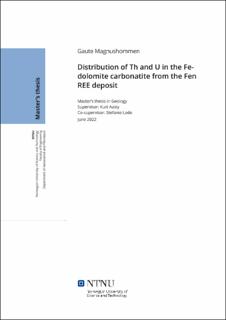| dc.contributor.advisor | Aasly, Kurt | |
| dc.contributor.advisor | Lode, Stefanie | |
| dc.contributor.author | Magnushommen, Gaute | |
| dc.date.accessioned | 2022-09-27T17:21:38Z | |
| dc.date.available | 2022-09-27T17:21:38Z | |
| dc.date.issued | 2022 | |
| dc.identifier | no.ntnu:inspera:111917593:64703939 | |
| dc.identifier.uri | https://hdl.handle.net/11250/3021941 | |
| dc.description.abstract | En detaljert karakterisering av thorium og uran er presentert basert på 12 prøver tatt fra materiale fra Fensfeltet i Ulefoss, Telemark, Norge. Prøvene ble sortert i tre kategorier og studert, basert på radioaktivitet. Det ble konkludert med at thorium hovedsakelig finnes som thoritt, og det er i noen tilfeller, lave thorium konsentrasjoner langs sjeldne jordarts (REE) mineralkorngrenser. De fleste thoritt kornene er mindre enn 50 µm og ikke større en 200 µm, unntatt en veldig liten fraksjon med avvik som når opptil 400 µm. Thoritt har et bredt spekter med assosiasjoner, men en konsistent høy relasjon til kalsitt, kvarts og ankeritt. Det var betydelig mindre uran i alle prøvene, og det forekom som uranitt og coffinitt. Majoriteten av uranitt og coffinitt kornene var under 25 µm og ikke større enn 100 µm. uranitt og coffinitt kornene er sterkt assosiert med svovelkis, kalsitt og i svakere grad ankeritt. Både thorium og uran viser kun en mulig svak korrelasjon til REE-ene ved lavere thorium, uran og REE konsentrasjoner. Når element konsentrasjonene stiger så synker korrelasjonen. Dette indikerer at det ikke er lite til ingen korrelasjon på høyere konsentrasjoner
De lette sjeldne jordartene (LREE) finnes i varierende konsentrasjoner i hver prøve. Lantan, cerium og neodym finnes hovedsakelig i følgende mineraler: parisitt, bastnäsitt, monazitt og synchysite. Mens praseodym og samarium hovedsakelig finnes i kalsitt karbonater, kvarts og apatitt for samarium. Disse mineralene korrelerer med tidligere studier fra området.
En rekke metoder ble brukt og viste seg nyttige for å karakterisere de radioaktive mineralene: radioaktiv avlesning på prøveoverflater ga en generell idé om thoriuminnhold, og optisk mikroskopi var brukbart når de radioaktive kornene var av større kornstørrelser. Røntgenfluorescens (XRF) viste seg nyttig for å kvantifisere hvert element, induktivt koblet plasma masse spektrometri (ICP-MS) fungerte også, og det kvantifiserte også flere REE enn XRF. Mikrocomputertomografi (μCT) kan vise seg å være et nyttig verktøy for å se teksturinformasjon i 3D, forutsatt at oppløsningen samsvarer med den generelle kornstørrelsen til de radioaktive mineralene i den analyserte prøven. SEM-basert automatisk mineralogi (AM) var hoved metoden som ble brukt og var kritisk for å kvantifisere kornstørrelse, elementfordeling og assosiasjoner. Metoden fungerer bra når trinnstørrelsen stemmer godt overens med kornstørrelsen, derfor kreves det litt kunnskap om prøven for best resultat. | |
| dc.description.abstract | A detailed characterisation of thorium and uranium is presented based on 12 specimens taken from material from the Fen carbonatite complex in Ulefoss, Telemark, Norway. The specimens were sorted based on radioactivity into three categories and studied. It was concluded that thorium is found mainly as thorite, and there are some instances of low thorium concentrations along Rare Earth Element (REE) mineral grain boundaries. Most thorite grains are smaller than 50 µm and no larger than 200 µm except a very small fraction of outliers that are no larger than 400 µm. Thorite has a wide range of associations with a consistent high relation to calcite, quartz, and ankerite. There was significantly less uranium in the specimens, and it occurs in uraninite and coffinite. Most of the uraninite and coffinite grains were below 25 µm and no larger than 100 µm. The uraninite and coffinite grains are strongly associated with pyrite and calcite and somewhat with ankerite. Both thorium and uranium only show a possible weak correlation towards the REEs at lower thorium, uranium and REE concentrations. As the element concentrations increase, the correlation lowers, indicating little to no correlation at higher concentrations.
The Light Rare Earth Elements (LREEs) are found in varying concentrations throughout each specimen. Lanthanum, cerium, and neodymium are found mainly in the following minerals: parisite, bastnäsite, monazite and synchysite. While praseodymium and samarium are both found mainly in carbonates, quartz and samarium is also found in apatite. These minerals correlate to previous studies in the area.
A range of methods was used and proved useful for characterising the radioactive minerals: radioactive reading on specimen surfaces gave a general idea of thorium content, and optical microscopy was viable when the radioactive grains were on the larger end. X-ray fluorescence (XRF) proved useful to quantify each element, inductively coupled plasma mass spectrometry (ICP-MS) also worked, and it also quantified more REEs than XRF. Micro-computed tomography (μCT) might prove a useful tool to view textural information in 3D, assuming the resolution matches the general grain size of the radioactive minerals in the analysed specimen. SEM-based automated mineralogy (AM) was the main method used and was critical to quantify grain size, element distribution, and associations. The method works well when the step-size closely matches grain size, therefore some knowledge of the specimen is required for the best result. | |
| dc.language | eng | |
| dc.publisher | NTNU | |
| dc.title | Distribution of Th and U in the Fe-dolomite carbonatite from the Fen REE deposit | |
| dc.type | Master thesis | |
